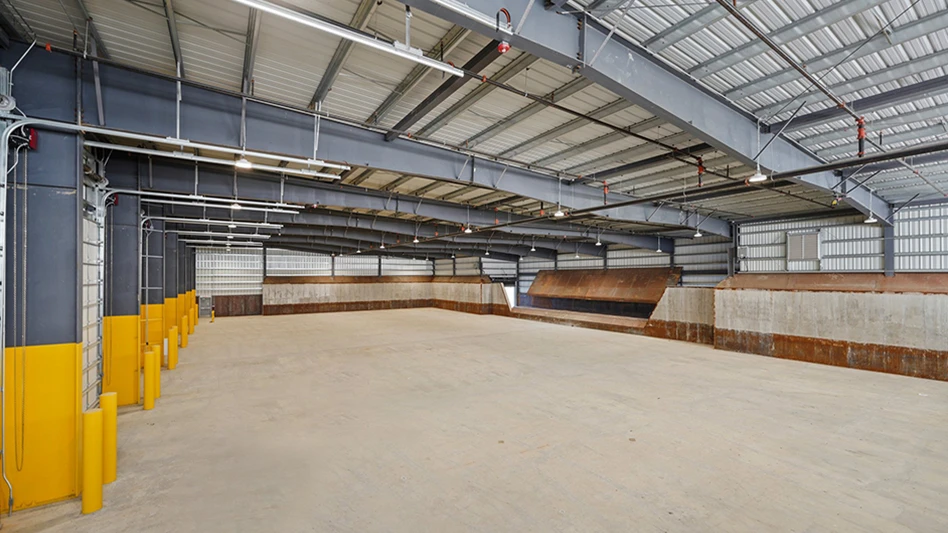
Solid waste facilities run at a frenetic pace. With high incoming volumes and demanding space constraints, efficiency is of the utmost importance. So when the team at Polk County Solid Waste Management in Minnesota saw an opportunity to ease the burden on its operators while simultaneously streamlining production, they jumped at the chance.
Not satisfied with how the county’s existing payloaders and excavators were performing at handling incoming waste, the team from Polk County Solid Waste Management partnered with a coalition of local municipal solid waste facilities in northern Minnesota to find a better solution.
Polk County participates in a regional integrated solid waste management program that includes the adjoining counties of Beltrami, Clearwater, Hubbard, Mahnomen and Norman.
Polk and Beltrami Counties, along with the four other adjacent counties, applied for, and were awarded, a capital assistance grant through the state of Minnesota to upgrade their respective waste facilities. That grant allocated funds for new equipment purchases, and the counties joined together to maximize their purchasing power.
In 2017, the teams began testing various machines from different suppliers. According to Polk Country Solid Waste Management Operations Manager Ron Larson, when operators got the chance to demo the Sennebogen material handler 818 E-Series provided by RMS-Road Machinery and Supplies in Grand Rapids, Minnesota, they knew they found the right fit.

“The selling points were it’s a very smooth-running machine. It’s super quiet, and we really liked that aspect of it because it’s running inside a building. We use it to load a feed hopper, it’s stockpiling waste for us and it’s loading walking floor trucks on a daily basis. We found that it’s just a really nice machine to run. We tested two other machines and we found out that the Sennebogen was just a great fit for us,” Larson says.
According to Larson, Polk County Solid Waste Management took ownership of the Sennebogen material handler 818 E-Series in September 2017 and started using the machine on-site in January 2018. Nearby Beltrami County Transfer Station also took ownership of one 818 E-Series in the fall of 2017. Polk County Transfer Station and the Polk County Landfill each got one 818 E-Series in spring 2018. In total, three new 818 E-Series Sennebogens were purchased in addition to a preowned E-Series for the landfill.
After outfitting the Sennebogen with a Rotobec clamshell bucket, the team was ready to put the machine into action. According to Larson, the difference became immediately apparent.
“This is the first material handler Polk County has owned,” Larson says. “We’ve had excavators and payloaders before, and this machine is different. It gives the operator the capability of just sitting in one spot and doing quarter turns to handle the material instead of having to completely rotate the machine 360 degrees or otherwise move it. It’s much more efficient. It can go from a pile of waste directly to a hopper with limited movement. This also equates to enhanced safety since you’re limiting your required movement.”
Greater efficiency was pivotal for the team at Polk County since the machine is tasked with managing a heavy workload. The facility runs the material handler seven hours per day, five days a week to process approximately 900 to 1,000 tons per week.
Larson says that despite the stresses the facility puts on the machine, the E-Series has proven extremely durable. He notes that for the routine maintenance that is required, most service can be done directly from the ground or from points that are easy to access from the top of the equipment.
Beyond greater efficiency, better safety and streamlined maintenance, Larson says the functionality of the Sennebogen material handlers is more seamless than any machine his operators have used. This translates to greater control and more comfort for the team’s personnel.
“These machines have a short learning curve. Our guys had run other equipment before, but the movement was limited—you couldn’t do much,” he says. “However, once they got into this machine, the motion was so fluid and you could even elevate the cab when you needed to so you could see what was going on better. Beyond that, within 10 or 15 minutes, you essentially had the motion of it down and understood how it handled. It’s been a very good machine for us.”
Get curated news on YOUR industry.
Enter your email to receive our newsletters.
Explore the November December 2019 Issue
Check out more from this issue and find your next story to read.
Latest from Waste Today
- ReMA board to consider changes to residential dual-, single-stream MRF specifications
- Miller Environmental Group Inc. appoints CEO
- DPI acquires Concept Plastics Co.
- Laurel Mountain Capital announces investment in 5280 Waste Solutions
- Cielo investor requests annual meeting
- WIH Resource Group celebrates 20th anniversary
- NWRA: NIOSH cuts a step in the wrong direction
- Valicor Environmental services acquires Affordable Waste Management






